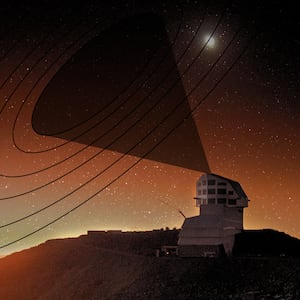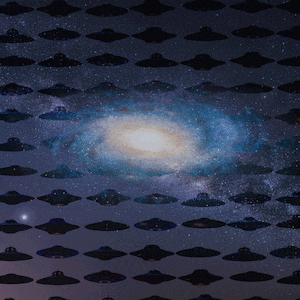More and more scientists are coming around to the idea, once controversial, that we’re probably not alone in the universe. After all, there might be hundreds of millions of Earth-like planets in the Milky Way galaxy. And the basic ingredients of evolution—water, volcanism and protein—seem to be fairly abundant.
So where are all the aliens? Where, to borrow a favorite term of the astronomical community, is the “Galactic Club”?
No one knows. But Jacob Haqq Misra, an astrobiologist at the Blue Marble Space Institute of Science in Seattle, has a theory. There could be lots of aliens out there. But they’re spreading across the galaxy in fits and starts, giving preferential treatment to certain types of stars and potentially heading in the opposite direction as us—at least, for now.
ADVERTISEMENT
“The possibility remains open that a Galactic Club exists,” Haqq wrote in his latest study on the subject, which appeared in The Astronomical Journal in December. But it could be that extraterrestrials are colonizing the Milky Way in such a way as to accidentally avoid Earth—and contact with Earth—for the time being.
Misra’s been working on this theory, and publishing studies on the subject, for a while now. It’s basically a proposal to tweak one famous mathematical equation to make sense of an equally famous logical paradox.
The Drake Equation—named for its creator, the late astrophysicist Frank Drake—calculates how many alien civilizations there should be, and how many of them we should be able to communicate with. It’s pretty simple. Multiply the number of stars by the number of habitable planets per star. Then multiply that by the number that might have life. Then multiply that by the number that could evolve intelligent life. Then finally, multiply that number by the time this intelligent life has had to broadcast radio messages.
Depending on your assumptions, the resulting number could be… a lot. Contrast that with the actual number of extraterrestrials the human race has made contact with: zero. There’s a name for this not knowing—a name for the seemingly illogical absence of aliens where aliens should be abundant. We call it the Fermi Paradox, after its inspiration, the late physicist Enrico Fermi.
Misra’s argument boils down to this: The latest version of the Drake Equation, which has been updated to take into account the rate at which alien civilizations should colonize neighboring stars, assumes all those aliens would spread outward from their home star systems in all directions at the same rate. Like a balloon inflating. The typical interpretation of the Fermi Paradox also “assumes that expansion would proceed uniformly through the galaxy,” Misra wrote.
But that’s not how a high-tech alien society would really go about colonizing its own corner of the galaxy, Misra argued. It doesn’t make sense for a civilization to launch colonization fleets in all directions at the same rate.
Space isn’t uniform, after all, so some of those fleets would be rocketing toward… well, not much. Other fleets would land on planets orbiting unstable stars that could fizzle or explode at any moment. “Not all stellar types may be equally useful for a long-lived civilization,” Misra wrote.
It makes more sense for E.T. to pick the best moments to colonize the best, most stable stars. More specifically, they might target planets around low-mass, K-type stars, which tend to live many billions of years longer than their bigger, hotter and more temperamental high-mass cousins. (Yes, our own Sun is a low-mass star, albeit a shorter-lived G-type one with a lifespan of around 10 billion years.)
Indeed, aliens would probably be familiar, and comfortable, with low-mass stars—because their own home star is likely to be low-mass, too. It took the human species 10 million years to evolve from ape-like ancestors. Those ape-like ancestors took four billion years to evolve from single-cell organisms. There’s no reason to believe aliens would evolve any faster. Evolution takes time. It begs for a very stable star.
There’s every reason to believe any intelligent species hoping to transplant itself into a new star system would seek out a star similar to its own. So Haqq said he expects E.T. to spread from one low-mass star to other low-mass stars, with a strong preference for the most durable K-type ones. He calls them a “Low Mass Galactic Club.”
That possible low-mass-star instinct alone maps out certain interstellar “highways” that rational aliens would travel as they colonize the galaxy. Maybe we haven’t found aliens because they’re heading away from us, leapfrogging from low-mass K-type star to the next low-mass K-type star.
It’s worth noting that our solar system is on the outer edge of the Milky Way, where stars are relatively few and far between. Closer to the galactic core, the density of stars increases by a factor of a hundred. Even if aliens chose low-density stars at random and included G-types, they’re more likely to expand away from us than toward us.
But Haqq argued they wouldn’t choose low-mass stars at random. Instead, they’d wait for the perfect moment to launch their colony ships—the moment when some nearby low-density star, orbiting around the galactic core like all stars do, passes nearest the aliens’ home star. “The travel time between stars is significantly less if the civilization is willing to wait a very long time for another star to approach more closely,” Haqq said.
By shortening the distance a colony fleet must travel, the aliens would boost the fleet’s chance of survival. Even if it required a degree of patience that’s inconceivable to human beings.
Haqq conceded that an alien civilization that can optimize its expansion might not look like, or function like, human civilization. “The only kind of civilization that could embark on an intentional plan to settle the entire galaxy is one that is able to rationally operate on very long—i.e., billion-year—timescales,” he said. “We have a long way to go with human civilization before we can even start planning on centennial to millennial timescales.”
In any event, what Haqq proposed is a kind of “throttled” expansion, where one alien species or another would patiently wait—for potentially millions of years—before launching its fleets, settling new planets and quickly, but briefly, expanding its galactic territory. Then settling in for another long wait.
The version of the Drake Equation that most scientists currently accept doesn’t take into account this occasional, convulsive expansion—or the possibility that aliens would consistently expand away from Earth and its G-type Sun. To make better sense of the Fermi Paradox, we need to add direction, frequency and preference to the Drake Equation.
For the growing number of scientists who believe in aliens, a tweaked Drake Equation isn’t just a way to explain why we haven’t met E.T. yet. It could actually help us make first contact—even if the closest aliens are expanding in the opposite direction as Earth to stars somewhat similar to, but also somewhat different than, our own.
That’s because our main approach to the search for extraterrestrial intelligence, or SETI, is radio-based eavesdropping—listening for radio transmissions that could have originated with some distant alien civilization.
One of the big challenges in SETI is deciding where to point our radio receivers. A more sophisticated Drake Equation could help astronomers weed out the stars that are least likely to harbor intelligent life.
“The immense forest of stars, dust and the like—just in our galaxy alone—tends to blur out any observable signs of extraterrestrial life should it exist, thus the Fermi Paradox,” Ross Davis, a specialist in information and communication sciences at Indiana University, told The Daily Beast.
Haqq’s tweaks to the Drake Equation “helps to focus SETI on the particular type of ‘tree’ or ‘trees’ in the forest where such civilizations may likely be.” That is, leapfrogging from one low-mass, K-type star to the next.
That’s half the point, Haqq wrote. “The search for technosignatures in low-mass systems provides one way to constrain the presence of such a Galactic Club.” In other words, if we’re going to listen for aliens, maybe we should listen to the star systems they’d most like to live in—and ignore the rest.










